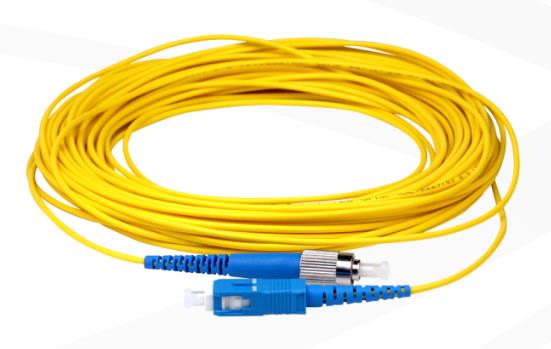Single-mode fiber (SMF) is a type of fiber optic cable used in telecommunications networks to transmit data over long distances. It is called "single-mode" because it is designed to transmit a single mode of light, or wavelength, down the fiber core. This design reduces signal loss and signal distortion, enabling data to travel further and at higher bandwidths than with other types of fiber optic cables.

Design and Construction
The core of a single-mode fiber optic cable is very thin, typically only 9 microns in diameter. This thinness enables the fiber to transmit light signals over long distances with minimal attenuation, or signal loss. The fiber is typically made of a high-purity glass or plastic material, which is chosen for its low attenuation and high strength.
To further reduce signal loss and signal distortion, single-mode fibers are typically coated with a cladding layer made of a slightly lower index of refraction material than the fiber core. This causes the light signals to reflect off the cladding layer and stay within the fiber core, reducing signal loss and distortion.
Applications
Single-mode fiber optic cables are used in many telecommunications applications where high bandwidth and long-distance transmission are required. They are particularly well-suited for transmitting data over long distances without significant signal loss or distortion. Common applications of single-mode fiber optic cables include:
Telecommunications Networks
Single-mode fiber optic cables are used extensively in telecommunications networks, such as internet backbones and long-haul networks. They enable high-bandwidth data transmission over long distances, making it possible to connect remote locations with high-speed data links.
Cable Television
Single-mode fiber optic cables are used to transmit cable television signals over long distances. This enables cable television providers to offer high-quality video signals to customers in remote locations, even in areas where it is not practical to run traditional copper coaxial cables.
Industrial Applications
Single-mode fiber optic cables are used in industrial applications where high levels of data security and reliability are required. They are often used to transmit data from remote sensors and monitoring systems in industrial plants and factories, where reliable data transmission is essential.
Advantages and Disadvantages
There are several advantages and disadvantages to using single-mode fiber optic cables in telecommunications networks:
Advantages:
High Bandwidth: Single-mode fibers can transmit data at very high bandwidths, making them well-suited for high-speed data transmission.
Long-Distance Transmission: Single-mode fibers can transmit data over very long distances without significant signal loss or distortion.
High Reliability: Single-mode fibers are very reliable, with a low incidence of signal loss or failure.
High Security: Because they transmit signals over very thin fibers, single-mode fibers are very difficult to tap or intercept, making them a highly secure option for transmitting sensitive data.
Disadvantages:
Complexity: Single-mode fiber optic networks can be more complex to design and install than other types of fiber optic networks.
Cost: Single-mode fiber optic cables are more expensive than other types of fiber optic cables.
Installation: Installing single-mode fiber optic cables requires specialized equipment and expertise, which can add to the cost and complexity of network installations.
Conclusion
Single-mode fiber optic cables are a vital component of modern telecommunications networks, enabling high-bandwidth data transmission over long distances. They are particularly well-suited for applications that require high levels of data security and reliability. While they may be more expensive and complex to install than other types of fiber optic cables, their high bandwidth, long-distance transmission capabilities, and reliability make them an essential part of any modern telecommunications network.
03-21
202502-12
202509-12
202409-05
202408-16
202408-07
202408-06
202408-02
202407-30
202407-29
2024
